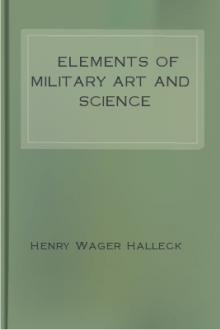Elements of Military Art and Science, Henry Wager Halleck [top young adult novels txt] 📗

- Author: Henry Wager Halleck
- Performer: -
Book online «Elements of Military Art and Science, Henry Wager Halleck [top young adult novels txt] 📗». Author Henry Wager Halleck
[51]
Even at the present moment, in ordering troops to Texas, where immediate and active service is anticipated, it is found necessary to break up regiments and send only the young and efficient officers into the field, leaving most of the higher officers behind with mere nominal commands. Very many of the officers now in Texas are acting in capacities far above their nominal grades, but without receiving the rank, pay, and emoluments due to their services.
But the importance of maintaining in our military organization a suitable system of military instruction is not confined to the exigencies of our actual condition. It mainly rests upon the absolute necessity of having in the country a body of men who shall devote themselves to the cultivation of military science, so as to be able to compete with the military science of the transatlantic powers. It is not to be expected that our citizen soldiery, however intelligent, patriotic, and brave they may be, can make any very great progress in military studies. They have neither the time nor opportunities for such pursuits, and if they can acquire a practical acquaintance with elementary tactics—the mere alphabet of the military art—it is as much as can reasonably be expected of them. As a general rule, the militia are individually more capable and intelligent than the men who compose a regular army. But they must of necessity be inferior in practical professional knowledge.
Technical education is necessary in every pursuit of life. It is possible that the lawyer may succeed in some particular cases without a knowledge of law, but he will probably have few clients if he remain ignorant of the laws and precedents that govern the courts. The unlearned chemist may succeed in performing some single experiment, but his progress will be slow and uncertain if he neglect to make himself familiar with the experiments and discoveries of his predecessors.
Learning, when applied to agriculture, raises it from a mere mechanical drudgery to the dignity of a science. By analyzing the composition of the soil we cultivate, we learn its capacity for improvement, and gain the power to stimulate the earth to the most bountiful production. How different the results attending the labors of the intelligent agriculturist, guided by the lamp of learning, from those of the ignorant drudge who follows the barren formula of traditional precepts! As applied to manufactures and the mechanical arts, learning develops new powers of labor, and new facilities for subsistence and enjoyment. Personal comforts of every kind are greatly increased, and placed within the reach of the humbler classes; while at the same time the "appliances of art are made to minister to the demands of elegant taste, and a higher moral culture." As applied to commerce, it not only greatly increases the facilities for the more general diffusion of civilization and knowledge, but is also vastly influential in harmonizing the conflicting interests of nations.
Nor is learning less humanizing and pacific in its influence when applied to the military art. "During the dark ages which followed the wreck of the Roman power, the military science by which that power had been reared, was lost with other branches of learning. When learning revived, the military art revived with it, and contributed not a little to the restoration of the empire of mind over that of brute force. Then, too, every great discovery in the art of war has a life-saving and peace-promoting influence. The effects of the invention of gunpowder are a familiar proof of this remark; and the same principle applies to the discoveries of modern times. By perfecting ourselves in military science, paradoxical as it may seem, we are therefore assisting in the diffusion of peace, and hastening on the approach of that period when swords shall be beaten into ploughshares and spears into pruning-hooks."
APPENDIX.Since the first edition of this work was published, two important wars have been commenced and terminated—that between the United States and the Republic of Mexico, and that between Russia and the Western Powers of Europe—and another is now being waged between France and Austria, upon the old battle fields of Northern Italy. In issuing a new edition of these Elements of Military Art and Science, it is deemed proper to refer to these wars, and to apply the principles here discussed to the military operations carried on in Mexico and in the Crimea. It is proposed to do this in the form of Notes to the several Chapters. The war in Italy being still undetermined, and the details of the several battles which have already been fought being but imperfectly known, it is obviously improper to attempt to criticize their strategic character or tactical arrangement.
H.W.H.
NEW YORK, July, 1859.
NOTE TO CHAPTER II.—STRATEGY.
In the invasion of Mexico, the United States formed four separate armies, moving on four distinct lines of operation: 1st. The "Army of the West," under General Kearny, moving from St. Louis on New Mexico and California; 2d. The "Army of the Centre," under General Wool, moving from San Antonio de Bexar on Chihuahua; 3d. The "Army of Occupation," on the Rio Grande, under General Taylor, moving from Corpus Christi on Matamoras, Monterey, and Saltillo; and 4th. The "Main Army," under General Scott, moving from Vera Cruz on the capital of Mexico.
The Army of the West, under General Kearny, moved upon a separate and distinct line of operations, having no strategic relations to the other three; its objects were the conquest and occupation of New Mexico and Upper California. The first was readily accomplished; but the general then detached so large a force to operate on Chihuahua after the diversion of Wool's column, that his expedition to California must have utterly failed without the assistance of the naval forces in the Pacific.
The lines of Taylor and Wool were evidently ill chosen, being so distant as to afford the enemy an opportunity to take a central position between them. Fortunately Wool proceeded no further than Monclova, and then turned off to occupy Parras, thus coming under the immediate command of General Taylor. The latter fought the battles of Palo Alto and Resaca de la Palma, and sustained the siege of Fort Brown; then crossing the Rio Grande at Matamoras, he captured Monterey, and, forming a junction with Wool, defeated the army of Santa Anna at Buena Vista. This battle ended the campaign, which, however brilliantly conducted, was entirely without strategic results.
Scott landed his army near the Island of Sacrificios without opposition, and immediately invested Vera Cruz, which surrendered after a short siege and bombardment. Having thus secured his base, he immediately advanced to the city of Puebla, meeting and defeating the army of Santa Anna at Cerro Gordo. Remaining some time at Puebla to reinforce his army, he advanced into the valley of Mexico, and after the brilliant victories of Contreras, Churubusco, Molino del Rey, and Chapultepec, captured the city and terminated the war.
With respect to the double line of operations of Taylor and Scott it may be sufficient to remark, that Santa Anna, from his central position, fought, with the same troops, the battles of Buena Vista and Cerro Gordo. It should also be remarked, that the line of operations of the army of the Rio Grande was not approved by either Scott or Taylor, nor, it is believed, by any other officer of our army. Scott's line of operations, however, was truly strategic, and in turning the Mexican flank by Lake Chalco and the Pedregal, he exhibited the skill of a great general.
The war in the Crimea, from the limited extent of the theatre of operations, afforded but little opportunity for the display of strategic skill on either side. Nevertheless, the movements of both parties, prior to the investment and siege of Sebastopol, are fair subjects for military criticism with respect to the plans of operation.
When the allies landed their troops at the Old Fort, three plans were open for the consideration of the Russian general: 1st. To destroy or close the harbors of Balaklava, Kamiesch, Kazatch and Strelitzka, and, garrisoning Sebastopol with a strong force, to occupy with the rest of his army the strong plateau south of the city, and thus force the allies to besiege the strong works on the north. 2d. Having closed the harbors on the south, and secured Sebastopol from being carried by the assault of any detachment of the allies, to operate on their left flank, annoying and harassing them with his Cossacks, and thus delay them many days in the difficult and precarious position which they would have occupied. 3d. To advance with his whole force and offer them battle at the Alma. The last and least advantageous of these plans was adopted, and as the garrison of Sebastopol, during the battle, consisted of only four battalions and the sailors of the fleet, it might, considering the weakness of its works, have been easily carried by a detachment of the allied forces.
For the allies at the Alma two plans presented themselves: 1st. To turn the Russian left, cut him off from Sebastopol, and occupy that city in force. 2d. To turn the Russian right, and, throwing him back upon Sebastopol, cut him off from all external succor. Neither plan was fully carried out. The column of General Bosquet turned the Russian left and decided his retreat; but no strategic advantage was taken of the victory. The battle was fought on the 20th of September, and by noon of the 26th the allies had only advanced to the Balbeck, a distance of a little more than ten miles in six days! On the 27th they regained their communication with the fleet at Balaklava, without attempting to occupy Sebastopol, and having exposed themselves to destruction by an ill-conducted flank march. Fortunately for the allies, the Russians failed to avail themselves of the advantages which the enemy had thus gratuitously afforded. The fleet having entered the open harbor of Balaklava, the allies now commenced the labor of landing and moving up their siege material and of opening their trenches, while the Russians prepared their fortifications on the south of Sebastopol for resisting the operations of that gigantic siege which stands without a parallel in history.
NOTE TO CHAPTER III.—FORTIFICATIONS.
In the war between the United States and Mexico, the latter had no fortifications on her land frontiers, and, with the single exception of Vera Cruz, her harbors were entirely destitute of defensive works. The Americans, therefore, had no obstacles of this kind to overcome on three of their lines of operation; and, when Scott had reduced Vera Cruz, his line of march was open to the capital. Moreover, nearly every seaport on the Gulf and Pacific coast fell into our hands without a blow. Had the landing of Scott been properly opposed, and Vera Cruz been strongly fortified and well defended, it would have been taken only after a long and difficult siege. Moreover, had the invading army encountered strong and well-defended fortifications on the line of march to Mexico, the war would, necessarily, have been prolonged, and possibly with a different result.
The Russian fortifications in the Baltic prevented the allies from attempting any serious operations in that quarter, and those in the Black Sea confined the war to a single point of





Comments (0)